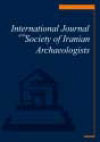فهرست مطالب
International Journal of the Society of Iranian Archaeologists
Volume:2 Issue: 3, Winter Spring 2016
- تاریخ انتشار: 1395/03/16
- تعداد عناوین: 7
-
-
صفحات 13-25
-
تجارت دریایی در خلیج فارس: شواهدی از آمفورهای اژدری ساسانیصفحه 26
-
صفحات 40-46
-
Pages 4-12The Kaftari ceramic assemblage has previously been dated to the late 3rd and early 2nd millennium b.c.e, and is primarily known as a result of surveys in the Kur River Basin and the excavations conducted at the site of Tal-e Malyan, i.e., the ancient city of Anshan. Various excavations have shown that Kaftari and Kaftari-related ceramic vessels have a wide distribution, including sites in various parts of Fars, the Bushire Peninsula and throughout the Persian Gulf. This paper will review the evidence for Kaftari and Kaftari-related ceramic material in southwest Iran and the Persian Gulf. It will then draw conclusions about the significance that the chronology and distribution of this material has for our understanding of the interaction between southwest Iran and the other areas that were involved in the Persian Gulf trading system that operated in the late 3rd and early nd millennium b.c.e.Keywords: Kaftari ceramics, Anshan, Persian Gulf, trade
-
Pages 13-25Archaeometallurgical research in the U.A.E. and Oman has demonstrated that local Bronze Age societies undertook copper production on a very large scale, providing solid evidence for the identification of this region as the land of Magan known in Mesopotamian sources as a key supplier of copper in the later 3rd millennium b.c. However, consideration of the textual, archaeological and archaeometallurgical evidence from across the greater Persian Gulf region indicates a more complex exchange system conditioned not only by raw material sources and trade routes, but by politics and warfare, by technological traditions of manufacture and recycling, by ideologies of elite consumption, and by the social obligations that created and underpinned exchange relationships. A great deal of work remains to be done to demonstrate the likely contribution of Iranian polities to this system.Keywords: Persian Gulf, Metal Trade, Bronze Age, Iranian Plateau, Arabian Peninsula, Mesopotamia
-
Ancient Maritime Trade in the Persian Gulf: the Evidence of Sassanid Torpedo AmphorasPage 26
-
Pages 40-46The Romans used the Latin phrase mare nostrum (our sea) to describe the Mediterranean as part of the Roman Empire. Using written and archaeological sources, this essay will attempt to show that the Persian Gulf was a mare nostrum for the Sasanian Persians in the same way that the Mediterranean was a mare nostrum for the Romans. The Sasanians considered the Persian Gulf to be part of their empire and made a systematic and continuous attempt to maintain control over it from the beginning of their dynasty in the third century c.e.Keywords: mare nostrum, Persian Gulf, Sasanians, Roman Empire
-
Pages 47-53The historical geography of the Persian Gulf has benefited from archaeological research to the extent that patterns of occupation begin to be evident. This is more dramatic in the Islamic and pre-Islamic periods, when some writings of the Arabic geographers come to testify to the settlements along this littoral and amplify the archaeological evidence. The following paper will examine this evidence and the implications for political domination from the northern, Iranian coasts, or more properly, from Fars province, and the economic or better the environmental instability which lead to shifting of primacy among these ports.Keywords: Persian Gulf, Fars province, Arabic geographers, Islamic, pre, Islamic periods
-
Pages 54-65In the National Archives of the Torre do Tombo in Lisbon, the Persian documents of 1 th-17th centuries are selected and preserved, in general, under a large category, called before Cartas Orientais or Documentos arábigos and, currently, Documentos Orientais. This collection forms a part of the funds of the Manuscritos da Casa dos Tratados. Some of these documents pertain to the Portuguese, in continuation of their policy of expansion in the Indian Ocean and the Persian Gulf in early 16th century who had reached the island of Hormuz, situated at 6 km from the Iranian coast. This great transit market of the Persian Gulf had then a population of approximately 40.000. Called until the 13th century Jarun, the island of Hormuz belonged to Iran and the rich kingdom of this island had for centuries depended on the central government of Iran. As for its kings, called in Persian sources volât-e Hormuz, they were until then the vassals of the Persian monarch. But, with the arrival of Portuguese, they became subordinates to Portugal. This paper deals with some of the documents from National Archives of the Torre do Tombo that deal with interaction of the kingdom of Hormuz and the Portugese.Keywords: National Archives of the Torre do Tombo, Island of Hormuz, Portuguese
-
Pages 66-86This study examines the history of what has traditionally been regarded as the oldest mosque on Bahrain. In addition to reviewing the available scholarship on the architectural history of the building, particular attention is paid to the epigraphic evidence, published a quarter of a century ago by Ludvik Kalus, which demonstrates conclusively the Shia nature of the mosque. These texts, in turn, clearly indicate the Shia character of the Uyunid dynasty which reigned in what is today eastern Saudi Arabia.Keywords: Bahrain, Persian Gulf, Mosque, Madrasah, Shiism


